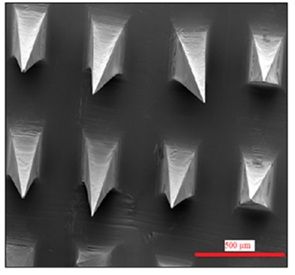The alternating layers of insulin and polymer enable the nanoparticle to slowly release insulin into the body as the polymer degrades. — Photos: Dr SYED MAHMOOD
For many diabetes patients, insulin is a crucial medicine required to help keep their blood sugar levels within normal range.
In Malaysia, the latest available National Diabetes Registry Report indicates that around 30% of diabetic patients are treated with insulin injections.
Exposure of body systems to an uncontrolled rise in blood sugar can lead to serious damage, especially to the kidneys, heart, eyes, blood vessels and nerves.
According to the World Health Organization (WHO), insulin is essential in reducing the risk of kidney failure, blindness and limb amputation.
It is typically prescribed for people with type 1 diabetes, as their bodies can’t produce it, and for type 2 diabetes patients whose oral medications are not sufficient to control their blood sugar levels.
Insulin is usually self-administered as a subcutaneous injection, i.e. under the skin.
This can be associated with pain and other complications, e.g. the formation of lumps or thickening of the skin due to repeated injections in the same area that cause the fat cells there to grow larger (i.e. lipohypertrophy).
The injection site therefore, should be rotated to avoid this problem and to maintain consistent insulin absorption.
These issues can affect patient compliance to their medication and potentially result in disease complications.
Extensive research has been conducted in search of alternative insulin delivery methods that offer advantages over the common needle.
Such research has resulted in delivery systems like implants, tablets, physical devices like microchips, micro-motor assisted tablets, self-orienting millipost devices (SOMAs), transdermal patches and microneedle capsules for intestinal delivery (LUMI).
Overall, oral insulin is the most efficient route as it mimics the body’s natural insulin pathway to the liver, thus increasing the availability of insulin after its intestinal absorption.
Oral insulin in the form of microspheres, beads, films, nanoparticles in microgel, nanoemulsion, micelles, carrier tablets and capsules have all been researched.
One key factor in the delivery of insulin into the body is the ability to release the dose in a consistent manner over a prolonged period of time.
Another factor specifically related to oral insulin is its ability to withstand the stomach’s acidic fluids in order to ensure that the insulin is not degraded before it gets absorbed in the intestine and into the body.
To tackle these issues, my colleagues and I prepared biodegradable, multi-layered nanoparticles using a natural polymer that can withstand the stomach’s acid.
Each nanoparticle was made out of alternating layers of insulin and the polymer.
This not only helped protect the nanoparticle from being digested by the stomach (via the polymer layers), but also enabled a slower release of the insulin over a longer period of time (due to the multiple layers of insulin).
While these nanoparticles can be delivered orally as a tablet, our team wanted to explore whether they could also be delivered through the buccal mucosa (the tissue on the inner part of our cheeks and lips) using micron-sized needles.
ALSO READ: Microneedles are a promising new way to deliver drugs
The nanoparticles were loaded into the needles, which were made of a biodegradable polymeric mixture.
The microneedles themselves are in the form of a patch, which is small enough to be folded and inserted into a capsule for the patient to swallow.
After passing through the mucosal layers, the particles would undergo biodegradation to release the insulin loaded within them.
According to our findings, published in the International Journal of Biological Macromolecules in June (2025), high insulin amounts were released into the intestinal fluids for a long duration (12-24 hours).
This is the first research to incorporate multilayered nanoparticles within micron-sized needles.
Moving forward, we aim to test the effectiveness of this delivery system in animals.
Dr Syed Mahmood is a senior lecturer at the Department of Pharmaceutical Technology in Universiti Malaya. For more information, email starhealth@thestar.com.my. The information provided is for educational and communication purposes only, and should not be considered as medical advice. The Star does not give any warranty on accuracy, completeness, functionality, usefulness or other assurances as to the content appearing in this article. The Star disclaims all responsibility for any losses, damage to property or personal injury suffered directly or indirectly from reliance on such information.







